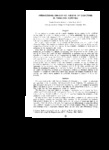Interacciones génicas no alélicas en caracteres de variación continua

View/
Date
1969Author
Cervantes Santana, Tarsicio
Bucio Alanís, Lauro
Metadata
Show full item recordAbstract
En este trabajo se considera que la expresión fenotípica de un carácter en los individuos de una población, se debe a efectos genéticos y a efectos ambientales. En los genéticos se incluyen aditividad (d), dominancia (h) e interacciones entre dos pares de genes alelomórficos (i, j y l) y se toma como origen de medida para d, h, i, j y l, la media de los padres P1 y P2, que es el sistema de medida de Van der Veen (F oo-metric). En la primera parte se trata con las medidas de generaciones y se da el modelo lineal aditivo que incluye las componentes genéticas arriba citadas; en este caso los efectos de cada componente se localizan en diferentes términos de cada ecuación y fácilmente se puede hacer la estimación de los parámetros del modelo. Para tener un conocimiento más claro del comportamiento de los efectos genéticos, se trabaja con las varianzas, y al obtener las ecuaciones para 18 generaciones con varianza genética en un sistema de 2 pares de genes alelomórficos, se encuentra que no existe una sola ecuación en la cual los efectos de las 5 componentes ya citadas no se confundan, es decir, dos efectos se encuentran en un solo término de la ecuación. Cuando se extiende la expresión de cada ecuación hacia un carácter cuantitativo, se tienen 5 términos con efectos no confundidos y 10 términos con efectos confundidos, y al suponer que estos diez términos últimos son de efectos iguales, éstos se reducen a uno solo (productos cruzados), el cual se elimina por manipulación algebraica entre dos ecuaciones de varianza de generaciones del mismo rango de ligamento. Se usa el mismo rango de ligamento con el fin de evitar perturbaciones por efectos de recombinación génica en el momento de hacer las estimaciones de los parámetros del modelo. En esta forma se tienen las 5 componentes genéticas en diferentes términos de la ecuación y se formula el modelo lineal aditivo para funciones de varianzas fenotípicas de generaciones, que incluye efectos genéticos de aditividad, dominancia y epistasis, y efectos ambientales. ABSTRACT: It is considered in this study that the phonotypical expression of a character in individuals of a population is due to genetical and environmental effects. Additivity (d), dominance (h), and interactions among two allelomorphic pairs of genes (i, j and l) are considered as genetical effects. The mean of parents P1 and P2 is the basis for the measurement of d, h, i, j, and l. This is the Van der Veen measurement system (F oo-metric). The first part of this study refers to the means of generations and it presents the linear additive model which includes the above genetical factors. In this case, the effects produced by each equation are located in different terms of each equation, therefore the estimation of the parameters of the model might be easily made. In order to have a more accurate knowledge of the effect produced by the behavior of the genetical factors, variances are considered. When equations for 18 generations are obtained, with genetical variance due to two allelomorphic pairs of genes it is found that there is no equation in which the effects of the above five components are differentiated. It means that effects due to different components are within the same term of the equation. When the expression of each covers a cuantitative carácter there are fice terms with differentiated effects, and ten terms with undifferentiated effects. Supossing these last ten terms produce equal effects, these terms are reduced to one (cross products) which is eliminated algebraically using two equations of the same degree of linkage. It es used the same degree of linkage in order to avoid genic disturbance caused by the effects of genic recombination when making the parametric estimation of the model. In this way, we have the five genetic components in different terms of the equation and the linear additive model is formulated for the functions of phenotypical variances of generations. This model includes genetical effects of additivity, dominance and epistasis, and environmental effects.
Collections
- Agrociencia [55]
